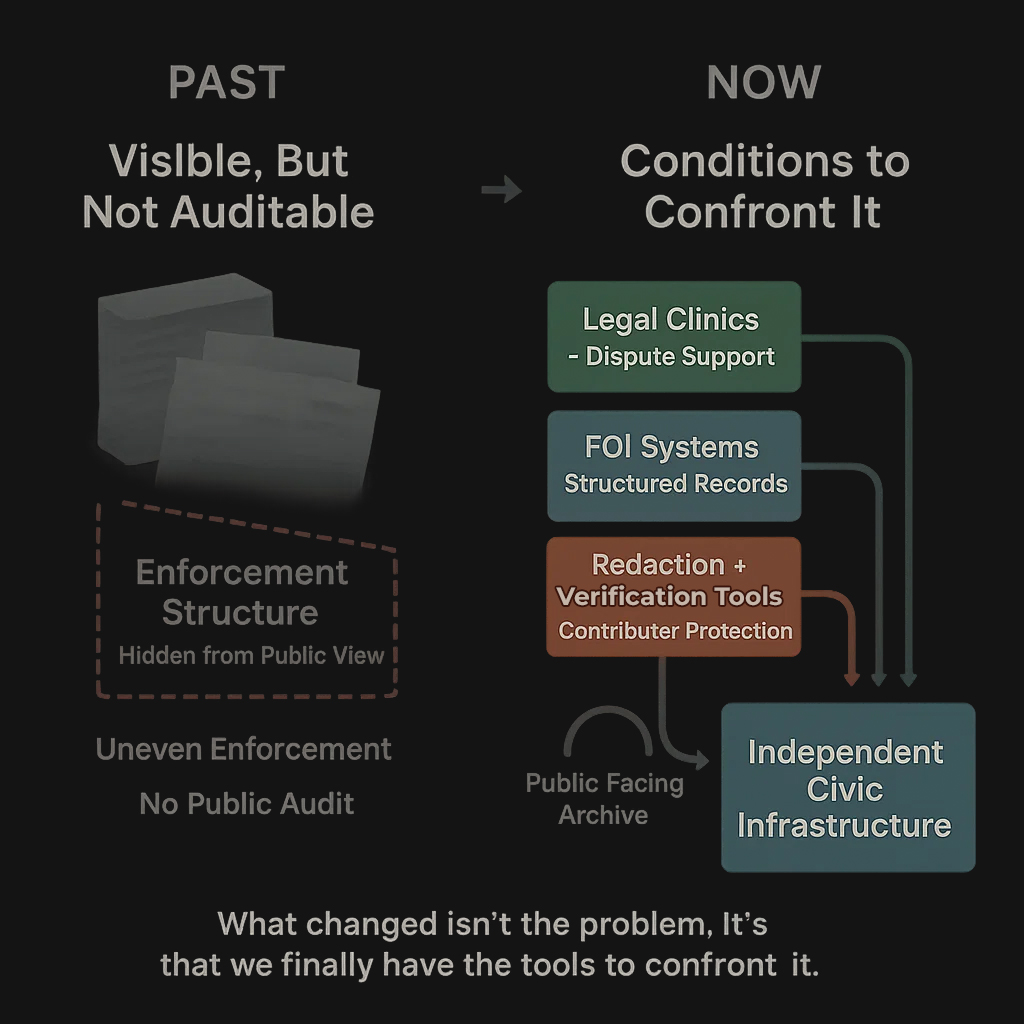Why Now? The Conditions That Made This Platform Necessary
For decades, enforcement systems have operated without visibility — issuing billions in fines with no public audit trail, no contributor protections, and no structural accountability. 200 Brady Street didn’t emerge because the technology became available. It emerged because the opacity became unsustainable, and the tools finally exist to expose it without compromise.
THE GAP HAS BEEN VISIBLE FOR YEARS BUT NEVER AUDITABLE
What’s changed isn’t the problem, it’s the tools to confront it
Traffic enforcement systems have been issuing tickets by the millions for decades. But until now, there was no public facing platform to see where those tickets came from, how they were issued, or what patterns they reveal. The public could feel the impact, but had no way to audit the structure behind it. Here’s why traditional civic tech never closed that gap.
What’s changed is the convergence of demand and capacity: legal clinics organizing for dispute support, FOI systems yielding structured records, and new tools that let us redact, verify, and index enforcement data without exposing contributors. The conditions finally exist to build what was missing, not as a civic app, but as independent infrastructure. See how contributor protections and redaction defaults are enforced.

Four Forces That Made 200 Brady Street Inevitable
This platform didn’t appear out of speculation. It emerged because four structural forces converged, making the need undeniable, and the build finally possible. Each force exposes a different layer of absence that this platform is designed to replace.
1. The Enforcement Economy Was Hidden in Plain Sight
For years, public conversations focused on the $7B+ market for enforcement technology, cameras, sensors, and software. But no one tracked the $20B-$50B generated in actual fines. There was no ledger, no audit, and no structured public record. See how 200 Brady Street reframes the enforcement market.
2. Legal Clinics and Researchers Lacked Structured Tools
Pattern based enforcement requires pattern based accountability. But clinics and civic researchers had no tools to bundle disputes, cross reference outcomes, or search records across jurisdictions. This platform was built to support justice aligned allies from the start.
3. FOI Systems and AI Tools Finally Unlocked Visibility
The documents existed, but they weren’t usable. Freedom of information requests yielded PDFs. Maps existed but weren’t searchable. Now, AI tooling and FOI scaffolding enable redaction, tagging, and indexing, without exposing the people who contributed. Explore how this unlocks Milestone 2.
4. Civic Tech Drifted Toward Optimization, Not Oversight
Most civic platforms today aim to improve how cities function, not to examine how those functions are enforced. 200 Brady Street isn’t an interface. It’s an accountability system. Here’s why it doesn’t follow the civic tech playbook.
“Transparency doesn’t happen because someone wants it.
It happens when the structure demands it and the tools finally exist to enforce it.”
200 Brady Street isn’t speculative. It’s structured. It doesn’t optimize enforcement, it audits it. And it exists because the conditions for accountability finally aligned.
Want to see how this structure comes to life?
- Explore Milestone 1 – live deployments and contributor protections
- See how the system governs itself not just its users
- Join us in building public infrastructure not just civic tools
Or contact us directly at invest@200bradystreet.com.
